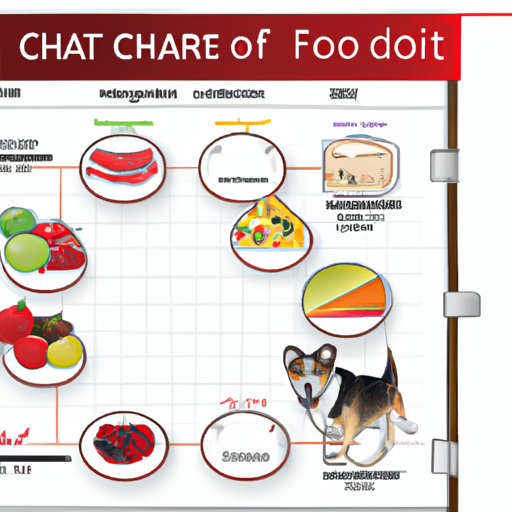As a caregiver, you are likely always on the lookout for ways to ensure the health and wellbeing of your loved ones, including your four-legged family members. Providing them with a balanced diet is crucial, but knowing what foods are harmful to dogs can sometimes be a challenge. This article aims to help you navigate the complexities of canine nutrition by providing you with a comprehensive chart of foods dogs can’t eat.
Understanding Canine Nutrition
Dogs are omnivores, and they can enjoy a variety of foods. But that doesn’t mean they should eat everything. Some foods that are perfectly safe for humans can be dangerous for dogs. These foods can cause digestive upset, damage internal organs, or even be fatal.
For a quick overview, here is a table of common foods that are unsafe for dogs.
| Food | Reason |
|---|---|
| Chocolate | Contains theobromine which can be toxic for dogs |
| Grapes and raisins | Can cause kidney failure |
| Onions and garlic | Can cause anemia |
| Alcoholic beverages | Can cause vomiting, disorientation, and potentially, death |
| Coffee and caffeine | Can cause restlessness, rapid breathing, heart palpitations, and seizures |
| Avocado | Contains persin which can cause diarrhea and vomiting |
| Macadamia nuts | Can cause weakness, vomiting, tremors, and hyperthermia |
| Xylitol | Can cause insulin release which can lead to liver failure |
The Dangers of Chocolate
Chocolate is one of the most well-known foods that are harmful to dogs. It contains a substance called theobromine, which dogs cannot metabolize effectively. Even a small amount of chocolate can cause vomiting, diarrhea, rapid breathing, and increased heart rate in dogs. In severe cases, it can lead to seizures, heart failure, and even death.
The Risk of Fruits: Grapes and Raisins
Grapes and raisins are particularly dangerous for dogs. Even a small amount can cause sudden kidney failure. Symptoms include vomiting, lethargy, and depression. Unfortunately, not all dogs exhibit symptoms, and some may seem fine until it’s too late. Therefore, it’s best to keep these fruits out of your dog’s reach.
Onions and Garlic: A Hidden Danger
Onions and garlic, whether raw, cooked, or in powder form, can cause anemia in dogs. Symptoms of anemia include weakness, vomiting, little interest in food, and breathlessness. If you suspect your dog has eaten onions or garlic, it’s important to seek veterinary care immediately.
Alcohol and Dogs Don’t Mix
Alcohol is another substance that is harmful to dogs. Even a small amount can lead to significant intoxication for a dog. Symptoms of alcohol poisoning in dogs include vomiting, disorientation, high body temperature, restlessness, excessive panting, and even seizures.
Coffee and Other Sources of Caffeine
Caffeinated beverages and foods, such as coffee and tea, can cause restlessness, rapid breathing, heart palpitations, muscle tremors, and seizures in dogs. In severe cases, it can be fatal.
Why Avocado is Bad for Dogs
While avocado is a healthy fruit for humans, it is not safe for dogs. It contains a toxin called persin, which can cause diarrhea, vomiting, and heart congestion in dogs.
Macadamia Nuts and Dogs
Macadamia nuts are another food that dogs should avoid. Ingestion can lead to weakness, vomiting, tremors, and hyperthermia (increased body temperature).
The Sweet Danger: Xylitol
Xylitol is a sweetener used in many products, including gum, candy, baked goods, and toothpaste. It can cause an insulin release in dogs, which can lead to hypoglycemia (low blood sugar) and can result in liver failure.
Frequently Asked Questions
1. What should I do if my dog eats a harmful food?
If you suspect your dog has ingested a harmful food, contact your vet immediately. They may instruct you to induce vomiting or bring your dog in for treatment.
2. Can dogs eat any human foods?
Yes, several human foods are safe and healthy for dogs. These include certain fruits and vegetables, lean meats, and some grains. Always consult with your vet before adding new foods to your dog’s diet.
3. Is it okay to give my dog a small amount of these harmful foods?
No, even small amounts of these foods can be harmful to dogs. It’s best to stick to dog-safe foods and treats.
4. What are some signs that my dog has eaten a harmful food?
Signs can vary, but often include vomiting, diarrhea, loss of appetite, lethargy, and behavior changes. If you notice any of these signs, contact your vet immediately.
Remember, as a caregiver, your role is to provide a safe environment for your loved ones, and that includes your pets. Using this guide, you can prevent accidental ingestion of harmful foods and ensure your dog stays healthy and happy.



